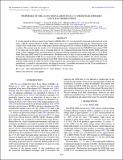PROPERTIES OF THE 24 DAY MODULATION IN GX 13+1 FROM NEAR-INFRARED AND X-RAY OBSERVATIONS
Author(s)
Corbet, Robin H. D.; Pearlman, Aaron B.; Buxton, Michelle; Levine, Alan M.
DownloadCorbet-2010-PROPERTIES OF THE 24.pdf (627.4Kb)
PUBLISHER_POLICY
Publisher Policy
Article is made available in accordance with the publisher's policy and may be subject to US copyright law. Please refer to the publisher's site for terms of use.
Terms of use
Metadata
Show full item recordAbstract
A 24 day period for the low-mass X-ray binary (LMXB) GX 13+1 was previously proposed on the basis of seven years of RXTE All-Sky Monitor (ASM) observations and it was suggested that this was the orbital period of the system. This would make it one of the longest known orbital periods for a Galactic LMXB powered by Roche lobe overflow. We present here the results of (1) K-band photometry obtained with the SMARTS Consortium CTIO 1.3 m telescope on 68 nights over a 10 month interval; (2) continued monitoring with the RXTE ASM, analyzed using a semi-weighted power spectrum instead of the data filtering technique previously used; and (3) Swift Burst Alert Telescope (BAT) hard X-ray observations. Modulation near 24 days is seen in both the K band and additional statistically independent ASM X-ray observations. However, the modulation in the ASM is not strictly periodic. The periodicity is also not detected in the Swift BAT observations, but modulation at the same relative level as seen with the ASM cannot be ruled out. If the 24 day period is the orbital period of system, this implies that the X-ray modulation is caused by structure that is not fixed in location. A possible mechanism for the X-ray modulation is the dipping behavior recently reported from XMM-Newton observations.
Date issued
2010-08Department
MIT Kavli Institute for Astrophysics and Space ResearchJournal
Astrophysical Journal
Publisher
Institute of Physics/American Astronomical Society
Citation
Corbet, Robin H. D., Aaron B. Pearlman, Michelle Buxton, and Alan M. Levine. “PROPERTIES OF THE 24 DAY MODULATION IN GX 13+1 FROM NEAR-INFRARED AND X-RAY OBSERVATIONS.” The Astrophysical Journal 719, no. 1 (July 23, 2010): 979–984. © 2010 American Astronomical Society.
Version: Final published version
ISSN
0004-637X
1538-4357